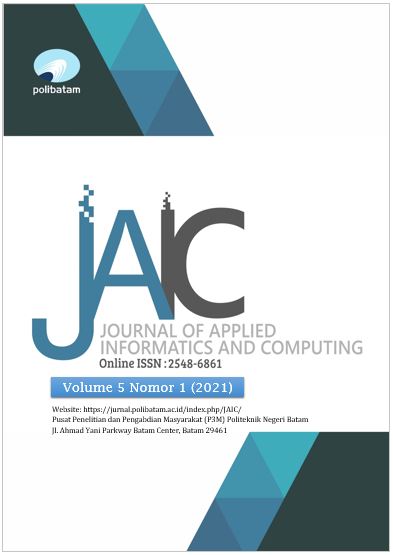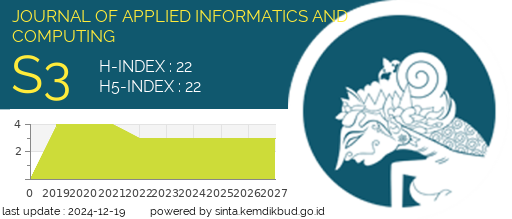Analisis User Interface pada Media Pembelajaran Bahasa Inggris Berbasis Game Visual Novel
DOI:
https://doi.org/10.30871/jaic.v5i1.2749Keywords:
Learning Media, User Interface, Usability, Heuristic Evaluation, Visual NovelAbstract
Heuristic evaluation in applicating of system evaluation is considered capable of being used in analyzing and testing the level of ease in operating visual-based English novel as learning media. The evaluation does not limit the assessment and measurement of the level of usability of the system by involving end users in the work and testing process. Therefore, heuristic evaluation is needed to determine how high the usability level of English learning media based on visual novels in the use of learning media. The research sample was aimed at the first semester of Information System department's students to provide an assessment of user interface of the learning media using probability sampling, proportionate stratified random sampling as the focus of the sampling technique that will fill out the questionnaire. The data in the study will be analyzed using a mix of qualitative and quantitative descriptive analysis methods. Based on the results of the study, it is stated that the visual-based English novel learning media interface layout design will be able to meet the criteria for heuristic evaluation and has good usability criteria and is easy to operate by users.
Downloads
References
M. N. El Ghiffary Et Al., "Analisis User Experience Pada Game Cs:Go Dengan Menggunakan Metode Cognitive Walkthrough Dan Metode Heuristic Evaluation," J. Pengemb. Teknol. Inf. Dan Ilmu Komput., Vol. 8, No. 3, Pp. 212"“219, 2017, Doi: 10.12962/J23373539.V7i1.28723.
L. L. Shidqi, V. Effendy, And A. Herdiani, "Model User Interface Aplikasi Pembelajaran Doa-Doa Harian Sesuai User Experience Anak Usia Dini Menggunakan Metode User Centered Design," E-Proceeding Eng., Vol. 4, No. 3, Pp. 4866"“4873, 2017.
Y. M. Geasela, P.- Ranting, And J. F. Andry, "Analisis User Interface Terhadap Website Berbasis E-Learning Dengan Metode Heuristic Evaluation," J. Inform., Vol. 5, No. 2, Pp. 270"“277, 2018, Doi: 10.31311/Ji.V5i2.3741.
N. Ratnasari And A. P. Wibawa, "Analisis Perbandingan Kualitas Ui/Ux Platform Online Coding Course Pada Pembelajaran Daring Pemrograman Komputer Dengan Metode A/B Testing," J. Edukasi Dan Penelit. Inform., Vol. 6, No. 2, P. 210, 2020, Doi: 10.26418/Jp.V6i2.40771.
W. W. N. Rahina, "Jurnal Imajinasi," J. Imajin., Vol. Xii, No. 2, Pp. 57"“64, 2018.
M. Damayanti, A. Aziz, And M. Ahsan, "Penerapan User Centered Design Dengan Pendekatan Uji Usability Pada Perancangan," Vol. 2, 2019.
W. H. Nunung Dwi Supriyono, Abdul Aziz, "Analisis User Interace Dan User Experience Pada Game Perang Komando Menggunakan Metode Heuristic Evaluation," Vol. 2, No. 1, P. 100, 2019.
A. R. Hidayat And E. Junianto, "Pengaruh Gadget Terhadap Prestasi Siswa Smk Yayasan Islam Tasikmalaya," J. Inform., Vol. 4, No. 2, Pp. 163"“173, 2017.
S. Sholiqah And R. Agustina, "Pengembangan Media Pembelajaran Animasi 3d Sistem Anatomi Tubuh Manusia," Vol. 2, Pp. 453"“463, 2019.
M. Bahariyani And I. S. Widiati, "Analisis Desain Antarmuka Portal Pembelajaran Online Menggunakan Evaluasi Heuristik," Vol. 6, No. 1, Pp. 10"“20.
U. Ependi, T. B. Kurniawan, And F. Panjaitan, "System Usability Scale Vs Heuristic Evaluation: A Review," Simetris J. Tek. Mesin, Elektro Dan Ilmu Komput., Vol. 10, No. 1, Pp. 65"“74, 2019, Doi: 10.24176/Simet.V10i1.2725.
D. U. Hidayah, I. R. Yunita, And G. Setyaningsih, "Evaluasi Website Kuliah Online Stmik Amikom Purwokerto Menggunakan Metode Heuristik (Studi Kasus Mata Kuliah Enterprise Resource Management)," Matrik J. Manajemen, Tek. Inform. Dan Rekayasa Komput., Vol. 18, No. 2, Pp. 171"“179, 2019, Doi: 10.30812/Matrik.V18i2.360.
W. Handiwidjojo And L. Ernawati, "Pengukuran Tingkat Ketergunaan (Usability) Sistem Informasi Keuangan Studi Kasus : Duta Wacana Internal Transaction (Duwit)," Juisi J. Inform. Dan Sist. Inf., Vol. 02, No. 01, Pp. 49"“55, 2016, [Online]. Available: Https://Journal.Uc.Ac.Id/Index.Php/Juisi/Article/View/115.
N. Dalimunthe, A. Dawiyah, F. Nazari, And K. Purba, "Evaluasi Website Pemko Pekanbaru Menggunakan Metode Heuristic Evaluation," J. Ilm. Rekayasa Dan Manaj. Sist. Inf., Vol. 5, No. 2, P. 245, 2019, Doi: 10.24014/Rmsi.V5i2.7538.
J. Raco, "Metode Penelitian Kualitatif: Jenis, Karakteristik Dan Keunggulannya," 2018, Doi: 10.31219/Osf.Io/Mfzuj.
N. Arifiati, "Analisis Faktor Yang Mempengaruhi Pemberian Asi Ekslusif Pada Bayi Di Kelurahan Warnasari Kecamatan Citangkil Kota Cilegon," J. Pros. Semin. Nas. Ikakesmada "Peran Tenaga Kesehat. Dalam Pelaks. Sdgs," Pp. 129"“125, 2017, [Online]. Available: Http://Eprints.Uad.Ac.Id/5411/1/18. Analisis Faktor Yang Mempengaruhi Pemberian Asi Ekslusif Pada Bayi Di Kelurahan Warnasari Kecamatan Citangkil Kota Cilegon.Pdf.
L. Putu And G. Cahyani, "E-Jurnal Akuntansi Universitas Udayana Pengaruh Tarif Pajak , Pemahaman Perpajakan , Dan Sanksi Perpajakan Fakultas Ekonomi Dan Bisnis Universitas Udayana ( Unud ), Bali , Indonesia Pendahuluan Pajak Merupakan Salah Satu Target Utama Pemerintah Yang Dijad," Vol. 26, Pp. 1885"“1911, 2019.
M. Setiono And R. Riwinoto, "Analisa Pengaruh Visual Efek Terhadap Minat Responden Film Pendek Eyes For Eyes Pada Bagian Pengenalan Cerita (Part 1) Dengan Metode Skala Likert," J. Komput. Terap., Vol. 1, No. 2, P. 169334, 2015.
Downloads
Published
How to Cite
Issue
Section
License
Copyright (c) 2021 Deli Deli

This work is licensed under a Creative Commons Attribution-ShareAlike 4.0 International License.
Authors who publish with this journal agree to the following terms:
- Authors retain copyright and grant the journal right of first publication with the work simultaneously licensed under a Creative Commons Attribution License (Attribution-ShareAlike 4.0 International (CC BY-SA 4.0) ) that allows others to share the work with an acknowledgement of the work's authorship and initial publication in this journal.
- Authors are able to enter into separate, additional contractual arrangements for the non-exclusive distribution of the journal's published version of the work (e.g., post it to an institutional repository or publish it in a book), with an acknowledgement of its initial publication in this journal.
- Authors are permitted and encouraged to post their work online (e.g., in institutional repositories or on their website) prior to and during the submission process, as it can lead to productive exchanges, as well as earlier and greater citation of published work (See The Effect of Open Access).











